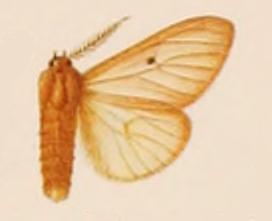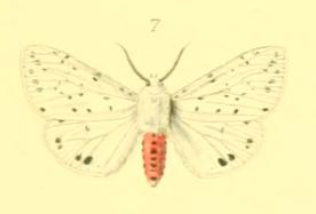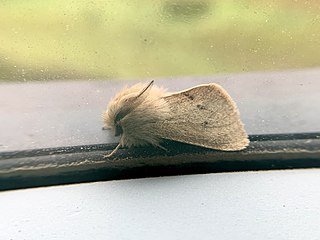
The buff ermine is a moth of the family Erebidae. It is sometimes placed in the genus Spilosoma. The species was first described by Johann Siegfried Hufnagel in 1766. It is found throughout the temperate belt of the Palearctic region south to northern Turkey, Georgia, Kazakhstan, southern Siberia, eastern Mongolia, Amur Region, China, Korea and Japan.

Spilosoma virginica is a species of moth in the subfamily Arctiinae. As a caterpillar, it is known as the yellow woolly bear or yellow bear caterpillar. As an adult, it is known as the Virginian tiger moth.

The agreeable tiger moth is one of three species of white tiger moth which are common in the United States. It has pronounced black eyes, white abdomen, and orange "bib" which set it apart from its cousin the Virginia tiger moth. Like its cousin, it tents its wings when as at rest.

Spilosoma lubricipeda, the white ermine, is a moth of the family Erebidae. It is found throughout the temperate belt of Eurasia from Europe through Kazakhstan and southern Siberia to Amur Region, China, Korea and Japan. In China several sibling species occur.

Spilosoma urticae, the water ermine, is a moth of the family Erebidae. It is found in temperate belt of the Palearctic realm like similar Spilosoma lubricipedum, but prefers drier biotopes. So, S. urticae is more abundant in steppes and it is the single Spilosoma species in Central Asia.

Spilosoma is a genus of moths in the family Erebidae originally described by John Curtis in 1825. A very heterogeneous group, it is in need of review by the scientific community, as certain species probably need reclassification into their own genera.

Abantiades latipennis, known as the Pindi moth, is a species of moth in the family Hepialidae. It may also be referred to as a swift moth or a ghost moth, as this is a common name associated with Hepialidae. Endemic to Australia and identified in 1932, it is most populous in temperate rainforest where eucalypti are prevalent, as the larvae feed primarily on the roots of these trees. Females lay eggs during flight in a scattering fashion. The larvae live for over eighteen months underground, while adult moths survive for approximately one week, as they have no mouthparts with which to feed. The moths are preyed upon by a number of predators, including bats and owls. Brown in colour overall, males are paler and the identifying silver bars of the male's wings are more prominent than those of the female's, with dark margins. Male adults are generally smaller.

Spilosoma sagittifera is a species of moth of the family Erebidae. It was described by Frederic Moore in 1888. It is found in India, Nepal, China and Taiwan.

Spilosoma pellucida is a moth of the family Erebidae. It was described by Walter Rothschild in 1910. It is found in Ghana.

Spilosoma punctaria is a moth in the family Erebidae. It was described by Caspar Stoll in 1782. It is found in the Russian Far East, China, Korea, Taiwan and Japan.
Spilosoma danbyi, or Danby's tiger moth, is a moth in the family Erebidae. It was described by Berthold Neumoegen and Harrison Gray Dyar Jr. in 1893. It is found in North America, where it has been recorded from Washington and western Canada from British Columbia to Manitoba.

Spilosoma pteridis, the brown tiger moth, is a moth in the family Erebidae. It was described by Henry Edwards in 1875. It is found in the United States in western Oregon and Washington, British Columbia and northern Idaho. The habitat consists of wet forests west of the Cascades, including coastal rainforests, low elevation mixed hardwood-conifer forests, as well as higher elevation conifer forests in the Cascades.
Spilosoma bipartita is a moth in the family Erebidae. It was described by Walter Rothschild in 1933. It is found in Angola, Congo, Kenya, Malawi, South Africa, Tanzania and Zimbabwe.

Spilosoma togoensis is a moth in the family Erebidae. It was described by Max Bartel in 1903. It is found in Cameroon, the Central African Republic, the Democratic Republic of the Congo, Equatorial Guinea, Ghana, Ivory Coast, Nigeria and Togo.

Spilosoma vestalis, the Vestal tiger-moth, is a moth in the family Erebidae. It was described by Alpheus Spring Packard in 1864. It is found along the coast of western North America, from California north to the Kitsap Peninsula in Washington and western Idaho. The habitat consists of wet forests, moist forests, coastal rainforests, low elevation mixed hardwood forests and high elevation mixed conifer forests.

Spilosoma vagans, the wandering diacrisia or wandering tiger moth, is a moth in the family Erebidae. It was described by Jean Baptiste Boisduval in 1852. It is found in western North America, from southern California, southern Utah and central Colorado north to southern British Columbia and south-western Alberta. The habitat consists of drier forests, including open ponderosa pine forests and mixed hardwood-conifer forests.

Spilosoma metaleuca is a moth in the family Erebidae. It was described by George Hampson in 1905. It is found in the Democratic Republic of the Congo, Eritrea, Nigeria and Sudan.
Spilarctia inexpectata is a moth in the family Erebidae. It was described by Walter Rothschild in 1933. It is found in New Ireland in Papua New Guinea.













